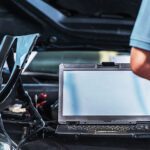Automotive Innovations for 2016
As automakers increasingly tout next-generation safety and convenience features, electronic interconnection designers and suppliers have more incentive than ever to stay ahead of the curve.
†
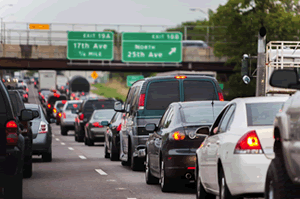
As more electronic functionality is added to automotive designs, congestion is becoming as big an issue in electronic interconnection as it is on the highway. (Photo courtesy of Mouser Electronics)
In an industry accustomed to long design cycles and proprietary solutions, burgeoning electronics options are creating new pressures for more rapid adoption by automotive designers.
Both external and internal forces are at play in this trend. Non-traditional companies, such as Tesla, Google, and Apple, are pushing the envelope of emerging advanced driver assistance systems (ADAS) to successfully launch viable “driverless” cars. Consumer electronics providers are constantly raising public expectations for instant access to a wider range of information and entertainment. At the same time, automakers themselves are trying to balance rising opportunities for product differentiation via innovative electronics against constant pressure for more cost-effective implementation.
The scope of opportunity is clear. According to Transparency Market Research, a global market research firm, electronics systems represent more than 90% of automotive innovations and new features, with the price of electronics/software content in autos representing up to 35% of the total cost in some vehicles.
Yet, with automotive wiring already being the third-heaviest and third-most-expensive component aside from the engine and chassis, perhaps the most crucial challenge for automotive designers in 2016 lies in finding more efficient ways to integrate the exciting new electronic functionality.
Safety and Reliability
More driver protection and safety systems are penetrating deeper into the marketplace with the projection that fully autonomous cars will be on the road in as little as five years. ADAS features originally available only on high-end models are now making their way into more mainstream vehicles. These capabilities include advanced emergency braking systems, lane departure warning systems, blind-spot detection, driver-attention systems, and more.
Reliability is the key challenge in these areas, according to Raymond Yin, the director of technical content at Mouser Electronics. “Engineers need to design fault-tolerant systems that are capable of safeguarding occupants even in the event of failure,” he says.
Connectivity and Infotainment
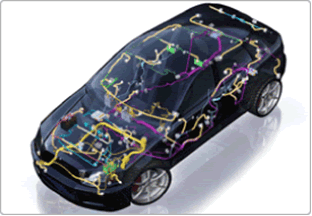
Evolving electronic functionality requires new electrical/electronic architectures in automotive designs. (Photo courtesy of Delphi Electronics)
Infotainment connectivity currently used to differentiate automotive brands and models spans WiFi Internet access, audio and visual entertainment, GPS navigation systems with real-time traffic information, instantaneous remote diagnostics, and even battery status-monitoring systems for hybrid and plug-in electrical vehicles.
Such enhanced capabilities, however, come with an added layer of concern for associated security challenges, according to Yin. “As cars become more connected to the larger world, even for simple features such as local search or map updates, they become vulnerable to outside tampering through wireless links,” he said. “Engineers need to anticipate potential vulnerabilities in both hardware and software, and to safeguard wireless systems through isolation or encryption.” As the Internet of Things (IoT) becomes more ubiquitous in the automotive environment, look for innovations like new wireless standards and silicon components with built-in encryption to be incorporated in new automotive designs.
In the short term, one quick and easy way to satisfy consumer desire for connectivity to infotainment is simply to make it easier for vehicles to support a driver’s existing personal electronic devices. For example, in contrast to the 10 years it took for the original USB standard to make its way into automotive applications, look for consumer expectations to drive implementation of USB Type-C and USB Power Delivery standards in a much shorter timeframe.
Consolidating Interconnection
The proliferation of automotive electronics makes it obvious that designers cannot continue to support all those new capabilities with a traditional wiring and control system dedicated to each functionality. The added demands of more sensors, control systems, and higher data speeds have spawned a wide range of new solutions, ranging from smaller connectors to entirely new networking approaches.
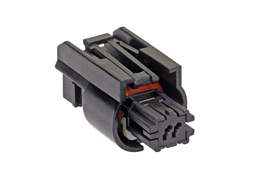
Smaller connector systems that can handle higher speeds, such as the Mini50 Connection System from Molex, are in high demand. (Photo courtesy of Mouser Electronics)
Mike Gardner, the global marketing manager for automotive infotainment and in-vehicle networks at Molex, reports on changing component designs to accommodate concerns about weight, space, and speed across connectivity, ADAS sensor, and control module applications. “The biggest way these trends affect connectors is the need for speed; all of them require connectors with higher bandwidths and higher data speeds,” he says. “With higher-speed connectors – particularly hybrid ones – comes the electromagnetic interference (EMI) generated when power is transmitted through the connectors.” For this reason, he cautions designers to account for protection from EMI and crosstalk.
“Of course, transmission speeds depend on the standards used,” Gardner explains. “Flex-Ray and CAN-bus standards operate well below the range of 10Mb/s, while Ethernet is currently available in the 100Mb/s range and is moving toward the 1Gb/s range in the near-term.”
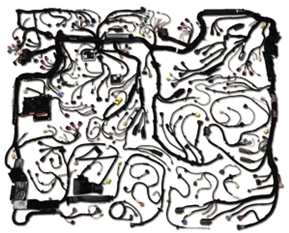
The rapid escalation of new electronic systems is straining the limits of existing automotive wiring harness design – already the third heaviest and third most costly component of automotive designs. (Photo courtesy of Delphi Electronics)
The desirability of whole-vehicle networks built on high-speed Ethernet derives in part from their ability to satisfy increasing speed and capacity demands without adding weight that saps fuel-efficiency. Industry research cites potential weight savings (up to 30%) and cost savings (up to 80%) through improved wiring and connector designs that incorporate unshielded twisted pair (UTP) cables.
Current 100Mb/s Ethernet solutions include a proprietary implementation for Tesla vehicles, and a 100Mb/s industry standard established by the OPEN (One-Pair EtherNet) Alliance, a special-interest group comprising more than 200 automotive industry OEMs and suppliers. But pending plans to achieve 1Gb/s transmission speed with single-pair wiring holds tremendous value for automotive applications, according to Steven B. Carlson, the chair of the IEEE P802.3bp 1000BASE-T1 PHY Task Force and president of High Speed Design, a consulting firm in Portland, Ore.
“Our task force is developing a standard for full-duplex operation at 1Gb/s over a single twisted-copper-wire pair, operating in a severely constrained environment,” Carlson reports. Specifically targeted at automotive networking, completion of the IEEE P802.3bp standard is anticipated later this year. “The 1Gb/s speed is very fast by the standards of current automotive networks and will allow automakers to deploy a vast number of new applications in infotainment, driver assist, and remote telematics,” says Carlson. “The ability of a network to accommodate both the signal volume and speed required by things like ADAS with just a single pair of copper wires can provide tremendous cost savings, plus weight savings, that contributes toward better fuel economy.”
Carlson foresees adoption of 1Gb/s Ethernet and the use of cellular mobile connectivity as an enabler for greater data sharing – within each vehicle as well as to and from vehicles. “Networking all in-car functionality and having the ability to share that data externally will not only enable vehicles to detect and navigate intermittent troublesome road conditions – such as patchy fog, rain, or accidents – but also allow them to share data with external sources. That means the same data on wet road conditions used by internal vehicle control systems to calculate breaking distance can be shared with external resources that can provide warnings to other vehicles approaching the same location. Likewise, your vehicle can benefit from data collected by vehicles ahead of you on the highway.”
A critical part of Ethernet implementation through single-twisted-pair wiring is the reliability of data even at the highest-rated transmission speed. The IEEE P802.3bp standard’s use of Reed-Solomon error correction ensures accuracy despite potentially harsh condition in the automotive environment. Its ability to accommodate both high-latency and low-latency systems in a single networked solution will help automotive designers escape the need for discrete wiring solutions across diverse automotive systems.
[hr]
Author Peter Antoniewicz is a veteran freelance writer who covers high-tech and business-to-business topics for a variety of corporate, agency, and editorial clients. He has written on subjects ranging from embedded computing, electronics, and software to ag-chem, medical imaging, engineered solutions, industrial products, and business services. Email him at [email protected].

